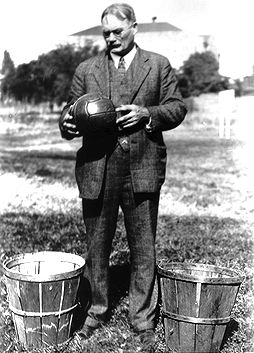
Invention of Basketball
Basketball was invented in 1891 by James Naismith at the YMCA International Training School (now Springfield College) in Springfield, Massachusetts. Naismith, an instructor at the school, responded to the need for an indoor winter recreational activity that could be easily learned and played in teams. Naismith wanted to develop a game that emphasized skill instead of force. The result was a team sport in which the object was to score by throwing a large ball into a (peach) basket placed about 3 m (or 10 feet) above the floor. Naismith also defined 13 basic rules, including prohibitions against running with the ball and “shouldering, holding, pushing, tripping, or striking in any way.”
Graduates of the YMCA training school in Springfield helped to spread basketball throughout the world. By the 1930s, it was played in countries around the world, prompting its acceptance as an official Olympic men’s competition in 1936.
Basketball in Canada
Many students at the YMCA International Training School in Springfield were Canadian, and these young men (e.g., Lyman Archibald, J. Howard Crocker, William H. Ball) helped establish the new game across the country. By 1900, basketball was being played in Canada by both men and women at local YMCAs and YWCAs, and in schools and clubs.
In 1923, the Canadian Amateur Basketball Association (CABA) was formed in Port Arthur [Thunder Bay], Ontario. As the official governing body for basketball in Canada, its main function was to assist with national championships, but its programs, beyond men's and women's national championships, now include: men's and women's national team development; technical development with coaching; official and player certification; youth programs; a Hall of Fame; educational services; and promotion and revenue generation. In 1973, the organization voted to adopt the international playing rules of the Fédération Internationale de Basketball Amateur/International Amateur Basketball Federation (FIBA). The CABA was renamed Basketball Canada by 1980, and later became Canada Basketball.
Basketball is one of the most popular sports in Canada. According to the Canadian Youth Sports Report, around 354,000 youth (age 3–17) played basketball in 2014, making it the sixth most popular sporting activity for young Canadians after swimming, soccer, dance, hockey and skating. Among new Canadians (those whose parents were born outside Canada), basketball was second only to soccer.
Professional Basketball in Canada
Canada’s first professional basketball teams began playing in the 1946–47 season. The Toronto Huskies played that season as part of the Basketball Association of America, a forerunner of the National Basketball Association. On 1 November 1946, Toronto hosted the league’s first game, playing the New York Knickerbockers at Maple Leaf Gardens. The Huskies lost to the Knickerbockers that evening and folded at the end of the season. On the West Coast, the Vancouver Hornets played in the Pacific Coast Professional Basketball League (1946–47 and 1947–48), before the league folded. It would be several decades until professional basketball returned to Canada. In the 1980s, Canadian teams began playing in minor professional leagues such as the Continental Basketball Association and the World Basketball League.
A new era in Canadian professional basketball began in 1994, when the National Basketball Association (NBA), the major professional league in the United States, awarded franchises to two Canadian cities. The Toronto Raptors and Vancouver Grizzlies, who both began play in 1995, brought major professional basketball to Canada for the first time. The Grizzlies were unsuccessful and moved to Memphis, Tennessee, in 2001. The Raptors continue as the league's only Canadian team. Support for the Raptors has grown, with increasing numbers watching or attending games. In 2005–06, the average attendance at Raptors home games was 17,056 (17th of 30 teams in the NBA), but by 2015–16, attendance had risen to 19,825 (4th of 30 teams). Between the 2010–11 and 2014–15 seasons, TV viewership for the Raptors more than doubled, from 108,000 to 246,000.
A growing number of Canadians have played on National Collegiate Athletic Association (NCAA) teams in the United States, and in the professional National Basketball Association and Women's National Basketball Association (WNBA). Canadian NBA players include Bob Houbregs, Bill Wennington, Rick Fox, Steve Nash, Cory Joseph and Andrew Wiggins. In 2005, while playing for the Phoenix Suns, Nash won the league's MVP award, becoming the first Canadian to receive the honour.
International Competition
Basketball appeared as a demonstration sport for male athletes at the 1904 Olympic Games in St Louis. The Edmonton Grads, a women's team, played a series of matches in conjunction with the 1924, 1928 and 1936 Olympic Summer Games. In 1936, men’s basketball first appeared as an official Olympic sport. Canada's team at the 1936 Berlin Olympiad, the Windsor Ford V8s, made up of players primarily from Windsor, Ontario, and strengthened by players from the West Coast, won the silver medal, losing in the final to the United States 19 to 8. Women’s basketball became an Olympic sport in 1976. Neither team has won an Olympic medal in basketball since 1936, but both have reached the podium at the Pan American Games and the FIBA Americas Championships. The women’s team has also won bronze medals at the FIBA World Championships.
Canada Men’s National Basketball Team (Medals)
Olympic Summer Games (Men)
|
1936 |
Silver |
FIBA Americas Championship (Men)
|
1980 |
San Juan, Puerto Rico |
Silver |
|
1984 |
Sao Paulo, Brazil |
Bronze |
|
1988 |
Montevideo, Uruguay |
Bronze |
|
1999 |
San Juan, Puerto Rico |
Silver |
|
2001 |
Nuequen, Argentina |
Bronze |
|
2015 |
Mexico City, Mexico |
Bronze |
FIBA World Championship (Men)
|
2023 |
Manila, Philippines |
Bronze |
Pan American Games (Men)
|
2015 |
Silver |
Canada Women’s National Basketball Team (Medals)
FIBA World Championship (Women)
|
1979 |
Seoul, South Korea |
Bronze |
|
1986 |
Vilnius, Minsk, Moscow, Soviet Union |
Bronze |
FIBA Americas Championship (Women)
|
1989 |
Sao Paulo, Brazil |
Bronze |
|
1993 |
Sao Paulo, Brazil |
Bronze |
|
1995 |
Hamilton, Ontario |
Gold |
|
1999 |
Havana, Cuba |
Bronze |
|
2003 |
Culiacan, Mexico |
Bronze |
|
2005 |
Hato Mayor, Dominican Republic |
Bronze |
|
2009 |
Mato Grosso, Brazil |
Bronze |
|
2011 |
Neiva, Colombia |
Bronze |
|
2013 |
Xalapa, Veracruz, Mexico |
Silver |
|
2015 |
Gold |
Pan American Games (Women)
|
1967 |
Bronze |
|
|
1979 |
San Juan, Puerto Rico |
Bronze |
|
1987 |
Indianapolis, Indiana |
Bronze |
|
1999 |
Winnipeg, Manitoba |
Silver |
|
2015 |
Gold |
Wheelchair Basketball
In 1946, about half a century after basketball was invented, American Second World War veterans played the first documented wheelchair basketball game. Two Canadian teams soon formed — the Vancouver Dueck Powerglides in 1950 and the Montréal Wheelchair Wonders in 1951. The game quickly became popular, and in 1968 the first Canadian championships were held in Edmonton, Alberta. Wheelchair basketball is now one of the most popular team sports for athletes with disabilities. The national men’s and women’s teams are among the best in the world, and since 1992 have won several Paralympic and world championships.

 Share on Facebook
Share on Facebook Share on X
Share on X Share by Email
Share by Email Share on Google Classroom
Share on Google Classroom








